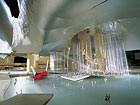|
|
|||||||||
|
GUGGENHEIM MUSEUM NEW
YORK New York 1998– This landmark structure is the outcome of an extensive process of refinement that began with an initial design for an unspecified location. In 1999, once a potential location on the site of four piers in Lower Manhattan was identified, the design underwent significant revisions that led to its current dramatic form. In its present iteration, the building responds to the urban landscape that serves as its backdrop and to the East River, which it faces. The rigid forms characteristic of a skyscraper—the quintessence of New York architecture—are fractured and recombined with a curvilinear body suggestive of the water's fluid movement and the energy of the city. The building's public function on the waterfront is central to its design. In a radical maneuver, the main body of the museum hovers above the river, allowing pedestrians uninterrupted views of the water. A promenade and extensive park space provide a much-needed gathering place along the river, and are supplemented by a sculpture garden and additional public amenities. Gehry's design implies that museums of the future might act not only as repositories for art objects but also as sites for civic engagement. The new facility will include exhibition galleries—for special exhibitions and for the Guggenheim's permanent collection—as well as centers for arts and technology, architecture and design, and education. There will also be a separate theater and performing arts center. Following Mayor Rudolph Giuliani's designation of the Solomon R. Guggenheim Foundation as the developer of the four piers and a commitment by the City of New York of a capital contribution of 67.8 million dollars in late November 2000, the Guggenheim has begun a three-year design development phase. This phase includes moving from conceptual to preliminary designs, obtaining environmental and zoning reviews and approvals, and input from the community, followed by completion of the final design. Once this process is completed, it is anticipated that construction will be carried out over three to four years. |
||||||||
